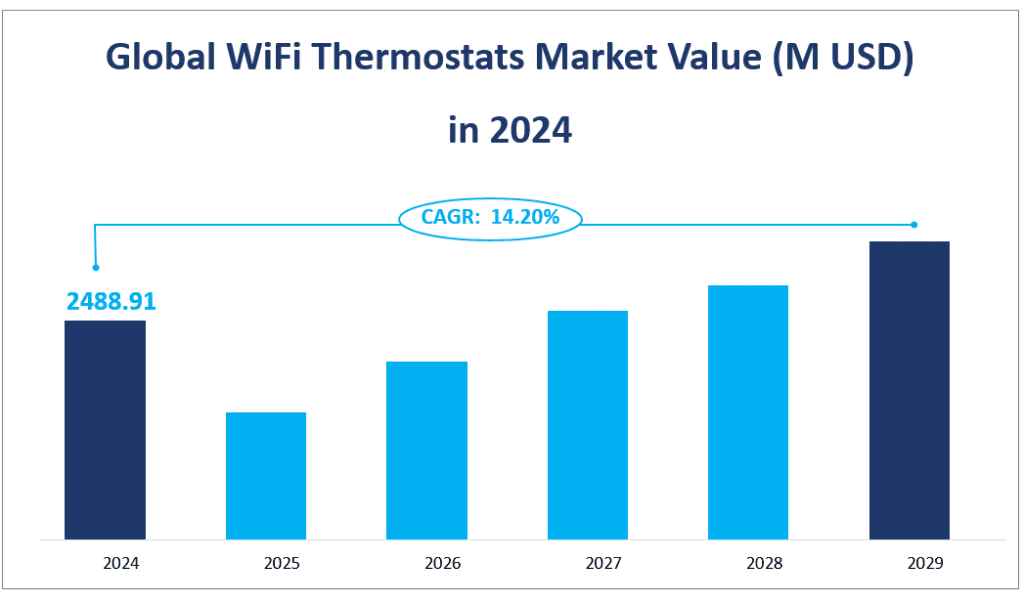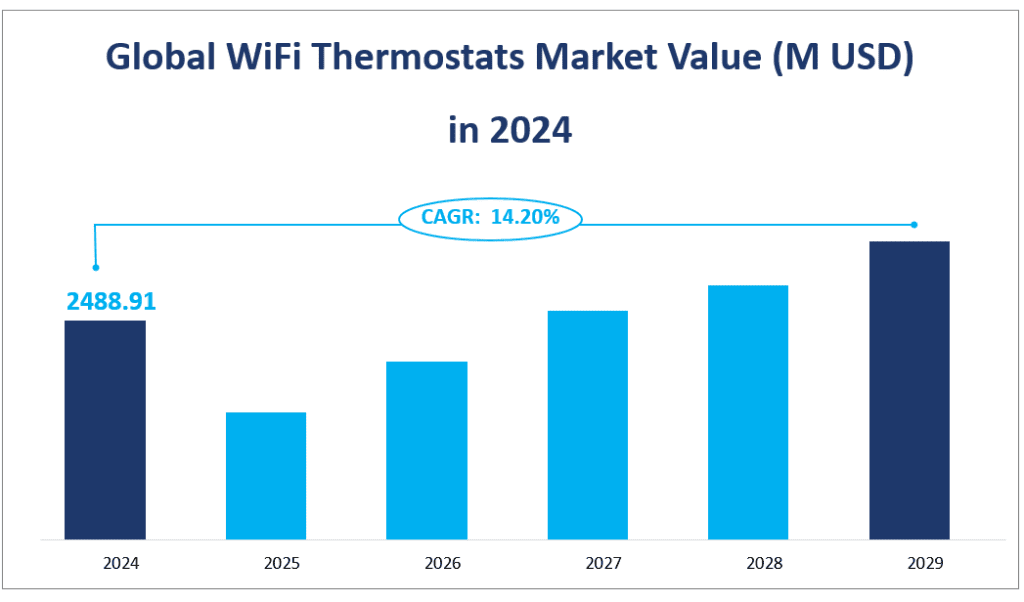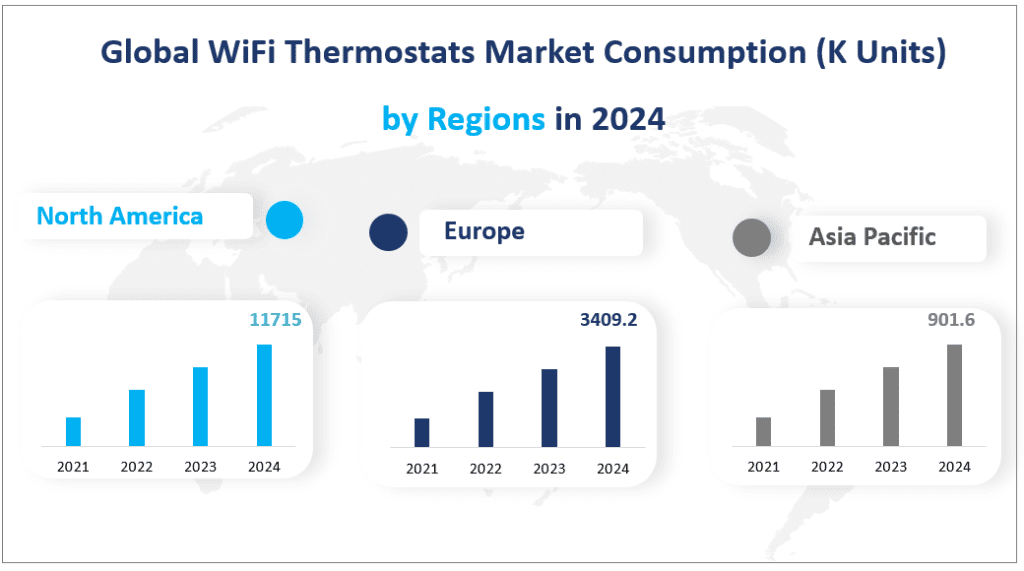1. Global WiFi Thermostats Market Overview
The global WiFi Thermostats market is projected to reach a significant milestone by 2024, with an estimated market value of $2488.91 million with a CAGR of 14.20% from 2024 to 2029.
A WiFi Thermostat is a smart home device that allows users to control their heating, ventilation, and air conditioning (HVAC) systems remotely via a smartphone app or web portal. These thermostats leverage WiFi connectivity to provide real-time monitoring and adjustments, enhancing energy efficiency and user convenience. Unlike traditional thermostats, WiFi thermostats can be programmed to adapt to users’ schedules, optimize energy usage, and integrate with other smart home devices.
The market scope of WiFi Thermostats includes both residential and commercial applications. In residential settings, these devices offer homeowners the ability to manage their indoor climate efficiently, reducing energy bills and improving comfort. For commercial users, WiFi thermostats provide a cost-effective solution for managing HVAC systems across large buildings or multiple locations, with features such as remote monitoring, automated scheduling, and energy consumption tracking.
Global WiFi Thermostats Market Value (M USD) in 2024


2. Driving Factors of WiFi Thermostats Market
Technological Advancements: The rapid development of IoT technology has enabled WiFi thermostats to become more intelligent and integrated. These devices can now learn user preferences, adapt to schedules, and optimize energy usage autonomously. This level of sophistication not only enhances user convenience but also drives energy savings, making them an attractive investment for both residential and commercial users.
Energy Efficiency and Cost Savings: WiFi thermostats offer significant energy savings by optimizing heating and cooling based on occupancy and user habits. This feature is particularly appealing to consumers and businesses looking to reduce their energy bills and carbon footprint. The long-term cost savings associated with these devices often outweigh their higher upfront costs, driving market adoption.
Smart Home Integration: As the smart home market continues to expand, WiFi thermostats are becoming an essential component of integrated smart home systems. Their ability to connect with other devices such as smart lights, security systems, and voice assistants enhances overall home automation, providing users with a seamless and interconnected living experience.
Remote Control and Monitoring: The ability to control and monitor HVAC systems remotely via smartphones or web portals is a major selling point for WiFi thermostats. This feature allows users to adjust temperatures from anywhere, ensuring optimal comfort and energy efficiency, even when they are not at home. This level of convenience is particularly valuable in today’s fast-paced lifestyle.
3. Limiting Factors of WiFi Thermostats Market
Higher Initial Costs: WiFi thermostats are generally more expensive than traditional thermostats, which can be a significant barrier for budget-conscious consumers. The higher upfront investment required may deter some potential buyers, despite the long-term benefits.
Installation Complexity: Installing a WiFi thermostat often requires technical knowledge and expertise, especially when integrating with existing HVAC systems. This complexity can be a deterrent for DIY enthusiasts and may necessitate professional installation, adding to the overall cost and inconvenience.
Compatibility Issues: The lack of standardized HVAC systems across different regions and building types can create compatibility issues for WiFi thermostats. This challenge limits their market reach and requires manufacturers to develop versatile products that can adapt to various systems.
Security Concerns: As with any connected device, WiFi thermostats are vulnerable to cybersecurity threats. Concerns about data privacy and potential hacking incidents may make some consumers hesitant to adopt these devices, especially in regions where cybersecurity awareness is high.
4. Analysis of WiFi Thermostats Market Segment
Market by Types
The global WiFi Thermostats market is segmented into two primary product types: Battery-powered and Hardwired. Each type has distinct characteristics that influence its market value and growth trajectory.
The Battery-powered WiFi Thermostats are projected to hold the largest market share in 2024. The market value for this segment is estimated to reach $1,915.13 million. This dominant position is attributed to the flexibility and ease of installation offered by battery-powered models, making them highly attractive for retrofitting into existing homes and commercial buildings.
Hardwired WiFi Thermostats are expected to have a market value of $573.78 million in 2024. While this segment has a smaller market share compared to battery-powered models, hardwired thermostats remain a preferred choice for new construction projects and commercial installations where a continuous power supply is essential.
The Battery-powered segment not only holds the largest market share but is also projected to exhibit the fastest growth rate. Battery-powered thermostats are favored by consumers for their ease of installation and flexibility. They can be easily retrofitted into existing HVAC systems without the need for professional installation, making them an accessible option for a broader market.
Continuous improvements in battery technology and energy efficiency have enhanced the performance and reliability of battery-powered models. Modern battery-powered thermostats can operate for extended periods without needing a recharge, addressing previous concerns about battery life.
Market Value and Share by Type
| Market Value (M USD) in 2024 | Market Share in 2024 | ||
| By Type | Battery-powered | 1915.13 | 76.95% |
| Hardwired | 573.78 | 23.05% |
Market by Applications
The Residential application of WiFi Thermostats is projected to hold the largest market share in 2024. The market consumption for this segment is estimated to reach 1,429.02 K Units. This dominant position is attributed to the widespread adoption of smart home technologies and the increasing awareness of energy efficiency among residential consumers. WiFi thermostats offer homeowners significant benefits, including remote control, energy savings, and enhanced comfort, making them a popular choice for retrofitting into existing homes and new construction projects.
On the other hand, the Commercial application of WiFi Thermostats is expected to have a market consumption of 2024.9K Units in 2024. While this segment has a smaller market share compared to residential applications, commercial users are increasingly recognizing the benefits of WiFi thermostats for managing HVAC systems in large buildings and multi-site operations. The ability to remotely monitor and optimize energy usage is particularly valuable for commercial users looking to reduce operational costs and improve sustainability.
The Residential application not only holds the largest market share but is also projected to exhibit the fastest growth rate. The rapid expansion of the smart home market is a significant driver for residential WiFi thermostats. Consumers are increasingly investing in smart home technologies to enhance convenience, security, and energy efficiency. WiFi thermostats are a key component of this ecosystem, offering seamless integration with other smart devices.
Residential users are highly motivated by the potential for energy savings and reduced utility bills. WiFi thermostats can optimize heating and cooling based on occupancy patterns and user preferences, resulting in significant cost savings over time. This economic benefit is a major factor driving market adoption.
Market Consumption and Share by Application
| Consumption (K Units) in 2024 | Market Share in 2024 | ||
| By Application | Commercial | 14290.2 | 87.59% |
| Residential | 2024.9 | 12.41% |
5. Regional WiFi Thermostats Market
North American region is projected to remain the largest market for WiFi Thermostats in terms of consumption, with an estimated volume of 11715 thousand units. This dominant position is attributed to the early adoption of smart home technologies, high disposable incomes, and a well-established HVAC infrastructure in the region. North America, particularly the United States and Canada, has been at the forefront of the smart home revolution, driving significant demand for advanced HVAC control solutions like WiFi thermostats.
The European market is expected to follow closely, with a consumption volume of 3409.2 thousand units in 2024. Europe’s strong focus on energy efficiency and environmental sustainability has been a key driver for the adoption of WiFi thermostats. Countries like Germany, the UK, and France have implemented stringent energy regulations, encouraging consumers and businesses to invest in smart HVAC solutions. Additionally, the growing popularity of smart home ecosystems in Europe has further fueled the demand for WiFi thermostats.
In contrast, the Asia-Pacific region is projected to exhibit the fastest growth rate in terms of consumption, despite starting from a smaller base. By 2024, the region is expected to consume 901.6 thousand units. Rapid urbanization, rising middle-class incomes, and increasing consumer awareness of smart home technologies in countries like China, Japan, and South Korea are driving significant market expansion. Additionally, government initiatives to promote energy-efficient buildings and smart cities are creating favorable conditions for the adoption of WiFi thermostats.
North America is identified as the largest regional WiFi Thermostats market. North America has been a pioneer in the development and adoption of smart home solutions, including WiFi thermostats. Consumers in the region are highly tech-savvy and willing to invest in advanced HVAC control systems. The region’s high per capita income levels enable consumers to afford premium smart home devices, driving the demand for WiFi thermostats.
Global WiFi Thermostats Market Consumption (K Units) by Regions in 2024


6. Analysis of the Top 3 Companies in the WiFi Thermostats Market
Nest is a leading brand in the smart home technology market, owned by Google LLC. Established in 2010, Nest is headquartered in the United States and primarily operates in North America and Europe. The company is renowned for its innovative smart home products, including WiFi thermostats, smart speakers, smart displays, smoke detectors, routers, and security systems. Nest’s WiFi Thermostats are designed to optimize energy usage and provide users with remote control capabilities via the Google Home app.
In the latest year, Nest reported a revenue of $516.36 million from its WiFi Thermostats. This strong performance is attributed to the company’s innovative product features, robust brand reputation, and extensive market reach in North America and Europe.
Ecobee is a Canadian home automation company founded in 2007. Headquartered in Canada, Ecobee primarily operates in North America and Europe. The company specializes in smart thermostats, temperature and occupancy sensors, smart light switches, smart cameras, and contact sensors. Ecobee’s products are designed to provide users with seamless control and integration with other smart home devices, enhancing overall home automation.
Ecobee’s WiFi Thermostats are known for their advanced features and user-friendly design. In the latest year, Ecobee reported a revenue of $275.04 million from its WiFi Thermostats. This strong performance is driven by the company’s focus on innovation, user-friendly design, and seamless integration with other smart home devices.
Honeywell is a multinational conglomerate founded in 1927 and headquartered in the United States. The company operates in four primary business segments: aerospace, building technologies, performance materials and technologies, and safety and productivity solutions. Honeywell’s WiFi Thermostats are part of its building technologies portfolio, designed to provide energy-efficient and user-friendly solutions for residential and commercial applications.
Honeywell’s WiFi Thermostats are designed to offer advanced control and energy savings. In the latest year, Honeywell reported a revenue of $166.00 million from its WiFi Thermostats. This performance is attributed to the company’s extensive product portfolio, strong brand reputation, and global market presence.
1 Wifi Thermostats Market – Research Scope
1.1 Study Goals
1.2 Market Definition and Scope
1.3 Key Market Segments
1.4 Study and Forecasting Years
2 Wifi Thermostats Market – Research Methodology
2.1 Methodology
2.2 Research Data Source
2.2.1 Secondary Data
2.2.2 Primary Data
2.2.3 Market Size Estimation
2.2.4 Legal Disclaimer
3 Wifi Thermostats Market Forces
3.1 Global Wifi Thermostats Market Size
3.2 Top Impacting Factors (PESTEL Analysis)
3.2.1 Political Factors
3.2.2 Economic Factors
3.2.3 Social Factors
3.2.4 Technological Factors
3.2.5 Environmental Factors
3.2.6 Legal Factors
3.3 Industry Trend Analysis
3.4 Industry Trends Under COVID-19
3.4.1 Risk Assessment on COVID-19
3.4.2 Assessment of the Overall Impact of COVID-19 on the Industry
3.4.3 Pre COVID-19 and Post COVID-19 Market Scenario
3.5 Industry Risk Assessment
4 Wifi Thermostats Market – By Geography
4.1 Global Wifi Thermostats Market Value and Market Share by Regions
4.1.1 Global Wifi Thermostats Value by Region (2015-2020)
4.1.2 Global Wifi Thermostats Value Market Share by Regions (2015-2020)
4.2 Global Wifi Thermostats Market Production and Market Share by Major Countries
4.2.1 Global Wifi Thermostats Production by Major Countries (2015-2020)
4.2.2 Global Wifi Thermostats Production Market Share by Major Countries (2015-2020)
4.3 Global Wifi Thermostats Market Consumption and Market Share by Regions
4.3.1 Global Wifi Thermostats Consumption by Regions (2015-2020)
4.3.2 Global Wifi Thermostats Consumption Market Share by Regions (2015-2020)
5 Wifi Thermostats Market – By Trade Statistics
5.1 Global Wifi Thermostats Export and Import
5.2 U.S. Wifi Thermostats Export and Import (2015-2020)
5.3 Europe Wifi Thermostats Export and Import (2015-2020)
5.4 China Wifi Thermostats Export and Import (2015-2020)
6 Wifi Thermostats Market – By Type
6.1 Global Wifi Thermostats Production and Market Share by Types (2015-2020)
6.1.1 Global Wifi Thermostats Production by Types (2015-2020)
6.1.2 Global Wifi Thermostats Production Market Share by Types (2015-2020)
6.2 Global Wifi Thermostats Value and Market Share by Types (2015-2020)
6.2.1 Global Wifi Thermostats Value by Types (2015-2020)
6.2.2 Global Wifi Thermostats Value Market Share by Types (2015-2020)
6.3 Global Wifi Thermostats Production, Price and Growth Rate of Battery-powered (2015-2020)
6.3.1 Global Battery-powered Production and Growth Rate (2015-2020)
6.3.2 Global Battery-powered Price (2015-2020)
6.4 Global Wifi Thermostats Production, Price and Growth Rate of Hardwired (2015-2020)
6.4.1 Global Hardwired Production and Growth Rate (2015-2020)
6.4.2 Global Hardwired Price (2015-2020)
7 Wifi Thermostats Market – By Application
7.1 Global Wifi Thermostats Consumption and Market Share by Applications (2015-2020)
7.1.1 Global Wifi Thermostats Consumption by Applications (2015-2020)
7.1.2 Global Wifi Thermostats Consumption Market Share by Applications (2015-2020)
7.2 Global Wifi Thermostats Consumption and Growth Rate of Commercial (2015-2020)
7.3 Global Wifi Thermostats Consumption and Growth Rate of Residential (2015-2020)
8 North America Wifi Thermostats Market
8.1 North America Wifi Thermostats Market Size
8.2 U.S. Wifi Thermostats Market Size
8.3 Canada Wifi Thermostats Market Size
8.4 Mexico Wifi Thermostats Market Size
8.5 The Influence of COVID-19 on North America Market
9 Europe Wifi Thermostats Market Analysis
9.1 Europe Wifi Thermostats Market Size
9.2 Germany Wifi Thermostats Market Size
9.3 United Kingdom Wifi Thermostats Market Size
9.4 France Wifi Thermostats Market Size
9.5 Italy Wifi Thermostats Market Size
9.6 Spain Wifi Thermostats Market Size
9.7 The Influence of COVID-19 on Europe Market
10 Asia-Pacific Wifi Thermostats Market Analysis
10.1 Asia-Pacific Wifi Thermostats Market Size
10.2 China Wifi Thermostats Market Size
10.3 Japan Wifi Thermostats Market Size
10.4 South Korea Wifi Thermostats Market Size
10.5 Southeast Asia Wifi Thermostats Market Size
10.6 India Wifi Thermostats Market Size
10.7 The Influence of COVID-19 on Asia Pacific Market
11 Middle East and Africa Wifi Thermostats Market Analysis
11.1 Middle East and Africa Wifi Thermostats Market Size
11.2 Saudi Arabia Wifi Thermostats Market Size
11.3 UAE Wifi Thermostats Market Size
11.4 South Africa Wifi Thermostats Market Size
11.5 The Influence of COVID-19 on Middle East and Africa Market
12 South America Wifi Thermostats Market Analysis
12.1 South America Wifi Thermostats Market Size
12.2 Brazil Wifi Thermostats Market Size
12.3 The Influence of COVID-19 on South America Market
13 Company Profiles
13.1 Nest
13.1.1 Nest Basic Information
13.1.2 Wifi Thermostats Product Profiles, Application and Specification
13.1.3 Nest Wifi Thermostats Market Performance (2015-2020)
13.2 Ecobee
13.2.1 Ecobee Basic Information
13.2.2 Wifi Thermostats Product Profiles, Application and Specification
13.2.3 Ecobee Wifi Thermostats Market Performance (2015-2020)
13.3 Honeywell
13.3.1 Honeywell Basic Information
13.3.2 Wifi Thermostats Product Profiles, Application and Specification
13.3.3 Honeywell Wifi Thermostats Market Performance (2015-2020)
13.4 Hive
13.4.1 Hive Basic Information
13.4.2 Wifi Thermostats Product Profiles, Application and Specification
13.4.3 Hive Wifi Thermostats Market Performance (2015-2020)
13.5 Carrier
13.5.1 Carrier Basic Information
13.5.2 Wifi Thermostats Product Profiles, Application and Specification
13.5.3 Carrier Wifi Thermostats Market Performance (2015-2020)
13.6 Emerson
13.6.1 Emerson Basic Information
13.6.2 Wifi Thermostats Product Profiles, Application and Specification
13.6.3 Emerson Wifi Thermostats Market Performance (2015-2020)
13.7 Tado°
13.7.1 Tado° Basic Information
13.7.2 Wifi Thermostats Product Profiles, Application and Specification
13.7.3 Tado° Wifi Thermostats Market Performance (2015-2020)
13.8 Lennox
13.8.1 Lennox Basic Information
13.8.2 Wifi Thermostats Product Profiles, Application and Specification
13.8.3 Lennox Wifi Thermostats Market Performance (2015-2020)
13.9 Ingersoll Rand (Trane)
13.9.1 Ingersoll Rand (Trane) Basic Information
13.9.2 Wifi Thermostats Product Profiles, Application and Specification
13.9.3 Ingersoll Rand (Trane) Wifi Thermostats Market Performance (2015-2020)
13.10 Lux Products
13.10.1 Lux Products Basic Information
13.10.2 Wifi Thermostats Product Profiles, Application and Specification
13.10.3 Lux Products Wifi Thermostats Market Performance (2015-2020)
13.11 Netatmo
13.11.1 Netatmo Basic Information
13.11.2 Wifi Thermostats Product Profiles, Application and Specification
13.11.3 Netatmo Wifi Thermostats Market Performance (2015-2020)
14 Market Forecast – By Regions
14.1 North America Wifi Thermostats Market Forecast (2020-2025)
14.2 Europe Wifi Thermostats Market Forecast (2020-2025)
14.3 Asia-Pacific Wifi Thermostats Market Forecast (2020-2025)
14.4 Middle East and Africa Wifi Thermostats Market Forecast (2020-2025)
14.5 South America Wifi Thermostats Market Forecast (2020-2025)
15 Market Forecast – By Type and Applications
15.1 Global Wifi Thermostats Market Forecast by Types (2020-2025)
15.1.1 Global Wifi Thermostats Market Forecast Production and Market Share by Types (2020-2025)
15.1.2 Global Wifi Thermostats Market Forecast Value and Market Share by Types (2020-2025)
15.2 Global Wifi Thermostats Market Forecast by Applications (2020-2025)
